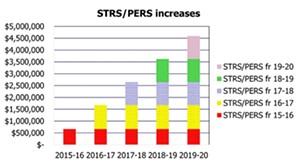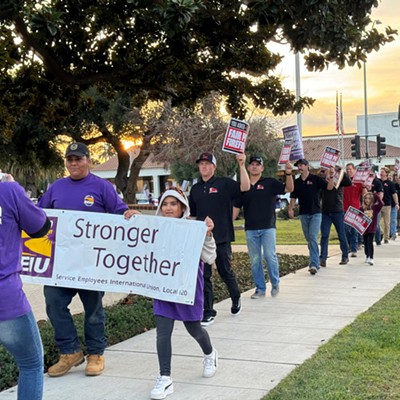The Santa Maria Joint Union High School District (SMJUHSD) announced on Aug. 18 its tentative agreement to increase all employee salaries by 1 percent for the 2017-18 fiscal year. The raise, according to Assistant Superintendent of Human Resources Kevin Platt, could have been higher if it weren’t for the district’s rising cost of retirement pension payouts, which is projected to increase by nearly $1 million each year for the next several years.
Without departmental and employee cuts, it’s entirely possible that within the next five years, the district won’t be able to pay its projected cost of retirement. For other school districts, Platt said, the situation is worse.

“Luckily, our attendance is growing,” Platt said, adding that school districts are given larger budgets for higher enrollment. “But at some point, we won’t be able to afford this anymore. At some point, the state will hopefully realize that.”
The district has about 400 teachers and 370 classified employees, most of whom are enrolled in retirement plans through the California Public Employees Retirement System (CalPERS) or the California State Teachers’ Retirement System (CalSTRS).
Both programs, Platt said, are in trouble.
In a June letter titled, “A Message to Our Members,” CalPERS Chief Executive Officer Marcie Frost directly addressed the organization’s most pressing issue: It has only 65 percent of the money needed to pay all the pension benefits CalPERS members have been promised.
“We keep that figure squarely in front of us at all times because the lower the number, the more at risk the fund is during turbulent economic times,” Frost wrote. “The percentage needs to be higher, and all of us at CalPERS are determined to bring it up.”
CalPERS pensions are funded through a sharing system, according to its website’s “CalPERS at a Glance” figures that were last updated June 2016. For every dollar paid to retirees, 62 cents comes from investment earnings and 25 cents comes from CalPERS employers, like SMJUHSD, other school districts, and other government agencies. The rest, 13 cents, comes directly from the paychecks of members, including teachers and other district employees.
CalPERS’s current state will affect more than 1,400 school districts and 1,500 public agencies enrolled in its retirement program, according to the organization.
SMJUHSD’s Platt said that after investments into CalPERS and CalSTRS decreased, the district’s pension rate rose to ensure retirees would get promised benefits. After a recent evaluation of the district’s budget, SMJUHSD leaders predicted that the cost of pensions will likely increase dramatically over the next several years. The cost for employees will also increase slightly.
“To make funding last we have to have more contributions,” Platt said, adding that teachers in California who depend on CalPERS and CalSTRS for financial stability after retiring often don’t pay into Social Security, so are dependent on the state pensions after retirement.
In fiscal year 2015-16, the district put a little more than $500,000 toward its retirement plans. For the fiscal year 2019-20, the district has estimated its cost of retirement will be more than $4.5 million.
The steep increase could make for a fiscally tricky future, Platt said, even if enrollment grows as projected. But if enrollment decreases, as Platt said it’s currently doing in many other school districts, the situation would be much worse. Still, he said, with enrollment growth comes a need for more teachers, and with more employees comes additional retirement costs.
For now, the district can only prepare for the worst.
The district’s negotiations with the Faculty Association and the California School Employees Association on a salary increase began in May. Platt said district employees have been informed about the current financial state throughout the process, and despite employees receiving less than initially requested, he said the negotiations, thus far, have been nothing but friendly.
“Our goal was to be honest and we left that on the table and said, ‘This is what we’ve got and what we’re able to do,’” Platt said. “We’re laying positive groundwork to move forward with.”
SMJUHSD spokesperson Kenny Klein said the fate of the tentative contracts now lies with the members of the Faculty Association and the California School Employees Association, who will vote for approval before September. If both unions ratify the contracts, the issue will then go before the school board on Sept. 12.
If all involved parties approve the tentative contracts, all SMJUHSD employees would receive a 1 percent salary increase effective immediately. The increase, according to Klein, would also come with a one-time bonus paid to each employee in the amount of 1 percent of his or her newly increased salary.
Klein said the tentative salary increase is part of something district employees call a “reopener.” Every three years, the district and its employee unions agree on three-year contracts that address benefits and pay. During each year of the contract, employees can choose a topic to reopen and renegotiate. This year, Klein said, they chose salary.
In the original 2015-18 contracts, Klein said, the Faculty Association received a 3.5 percent total raise in salary and benefits. The California School Employees Association received a 6.07 percent total raise in an effort to create pay equality among all the district’s employees, whether they are teachers or staffers.
In the past, Klein said, faculty members were typically given larger raises and better benefits. Now the district hopes to reward all employees equally.
“Due to the severe increase of retirement cost, we feel and we all agreed that the 1 percent was fair and equitable,” Klein said. “But members still have to ratify it.”
Staff Writer Kasey Bubnash can be reached at [email protected].









